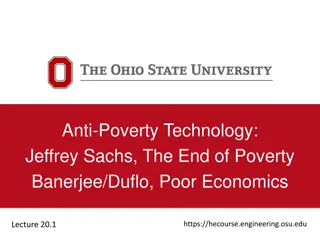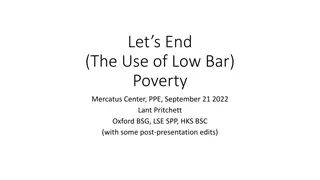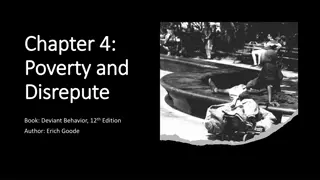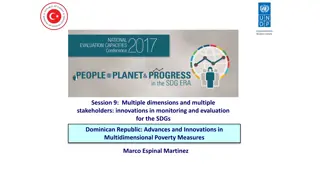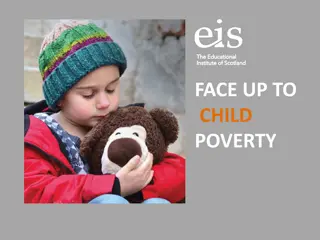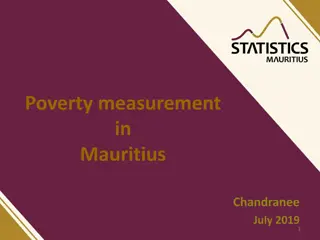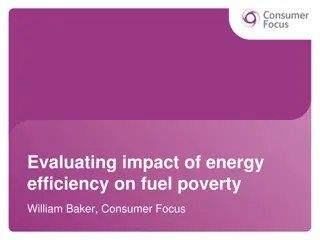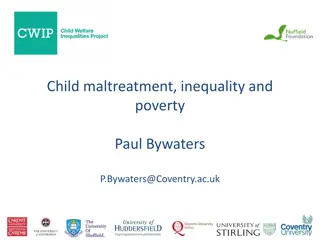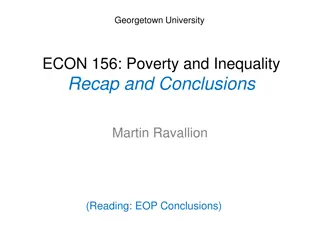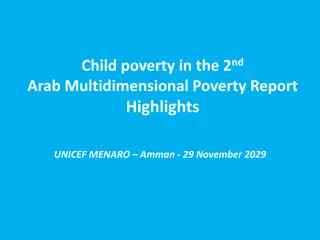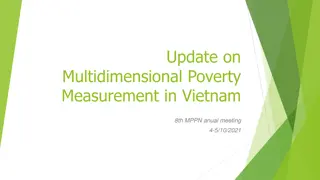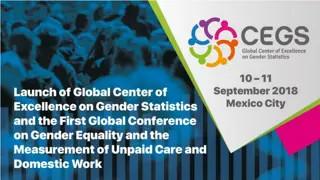
Child Poverty and Wellbeing in Australia
Explore the complexity of child poverty and wellbeing in Australia through the comparison of income and deprivation approaches. Learn about the Australian Child Wellbeing Project's findings, marginalized groups, and policy implications. See how child poverty rates vary by household type and number of children, and discover the importance of incorporating children's views in measuring wellbeing.
Download Presentation

Please find below an Image/Link to download the presentation.
The content on the website is provided AS IS for your information and personal use only. It may not be sold, licensed, or shared on other websites without obtaining consent from the author. If you encounter any issues during the download, it is possible that the publisher has removed the file from their server.
You are allowed to download the files provided on this website for personal or commercial use, subject to the condition that they are used lawfully. All files are the property of their respective owners.
The content on the website is provided AS IS for your information and personal use only. It may not be sold, licensed, or shared on other websites without obtaining consent from the author.
E N D
Presentation Transcript
Child Poverty and Wellbeing in Australia Melissa Wong Social Policy Research Centre University of New South Wales, Australia Presented to the COMPASS Seminar Series University of Auckland 20 May 2016
Outline Child poverty in Australia The income approach vs. the deprivation approach The Australian Child Wellbeing Project (ACWP) Deprivation rates and levels Wellbeing measures Marginalised groups and households arrangements Conclusions and policy implications
Child Poverty Rates by Household Type, 2011-12 60 50 40 50% median income 30 % 60% median income 20 10 0 Couple households Sole parent households All households
Child Poverty Rates by Number of Children and Age of Youngest Child, 2011-12
Child Poverty in Australia, 2003-04 to 2011-12 25 20 BHC 2003-04 income basis BHC 2005-06 income basis 15 BHC 2007-08 income basis % AHC 2003-04 income basis 10 AHC 2005-06 income basis AHC 2007-08 income basis 5 0 2003-04 2005-06 2007-08 2009-10 2011-12
The Conventional (Income) Approach Uni-dimensional Needs of children simply assumed using an equivalence scale or reflected through parental expenditure patterns Children are invisible and child poverty is the same as parental poverty Does not allow for the complexities and changing nature of children s actual lives
The Deprivation Approach Adopts a living standards perspective Is explicitly multi-dimensional, with no equivalence assumptions Emphasises the affordability of essential items Can be applied at different levels - the household and/or individuals (including children) Capable of incorporating children s views (Main and Bradshaw, 2012) United Nation s Convention on the Rights of the Child (UN CRC) where children s views should be given due weight on matters that affect them Produce measures that better explain variations in children s well-being a focus of the Australian Child Wellbeing Project
The Australian Child Wellbeing Project (ACWP) Australian Research Council Linkage Project (2012-2015) Flinders University University of New South Wales Australian Council for Educational Research (ACER) Department of Education Department of Social Services Australian Institute of Health and Welfare Australian Bureau of Statistics
The ACWP: Rationale Wellbeing is important for young people now, and for their healthy development. Young people themselves are the foremost experts on their own wellbeing. The middle years (age 8-14) receive less policy attention then early childhood and adolescent.
The ACWP: Project Framework An integrated mixed-method child-centred study Focus group discussions/interviews with young people (ages 8-14) Survey design National survey (Year 4, 6 and 8) Going back to young people
The ACWP: National Survey Questions covering wide areas of wellbeing -Family -Living arrangements -School -Health -Friends -Material wellbeing -Bullying -Subjective wellbeing Conducted between July to October 2014 Computer-based and online instrument; easy to read with audio assist Sample size: n=5,440 from 180 schools answered the survey Weights developed to according to sex and geolocation of schools.
Using ACWP Data to Measure Deprivation (1) Applied for the first time to measure poverty among young people in Australia Using data provided by young people themselves Deprivation indicators developed from international studies Family Affluence Scale (FAS) (Currie et al., 2008; Currie et al., 2012; Currie et al., 1997) Child Deprivation Scale (CDS) based on the work by Main (2014); Main and Bradshaw (2012) o Child s own views o Democratic/consensual approach International comparisons
Using ACWP Data to Measure Deprivation (2) ACWP has collected information on 1. Affluence level of the family as a whole; and 2. Child deprivation items: o An iPod or other music player o Some money to save each month, in a bank or at home o The right kinds of clothes to fit in with people of their age o Enough money to go on a school camp o Your own mobile phone Whether they have the item, Whether they don t have it but would like it, or Whether they don t have it but don t want or need it
Child Deprivation Rates by Item (%) Year 4 Year 6 Year 8 Full sample Item iPod 16.5 16.0 5.8 12.8 Money 21.5 19.3 19.4 20.1 Clothes 7.6 5.6 5.9 6.4 School camp 13.6 8.3 5.0 8.9 Mobile phone 53.3 44.0 12.9 36.6
Mean Deprivation Score for Children Deprived of Each Item (0-5 scale) Item Mean iPod 2.28 Money 2.03 Clothes 2.32 School camp 2.35 Mobile phone 1.65 All 0.83
Severity of Deprivation by Age (%, weighted) 80 70 60 50 0 items At least 1 item At least 2 items At least 3 items 40 % 30 ** ** 20 ** 10 0 Year 4 Year 6 Year 8 Total Level of statistical significance: *p<0.05, **p<0.01
Cantril Score by Level of Deprivation (mean score) 10 9 8 ** 7 6 Mean score 0 items At least 2 items 5 4 3 2 1 0 Cantril mean score
Life Satisfaction and Health by Level of Deprivation (%) 18 ** 16 14 12 10 ** % ** 0 items At least 2 items 8 ** 6 4 2 0 Life not going well No good life No positive future Subjective health poor/fair
Family Cohesion and Friendship by Level of Deprivation (%) 25 ** 20 15 % 0 items At least 2 items 10 ** 5 ** 0 Not had fun with family Not learning together No close friends
School Satisfaction and Teacher Connectedness by Level of Deprivation (%) 30 25 20 ** 15 % 0 items At least 2 items 10 ** 5 0 Do not like to go to school Do not find learning fun Do not feel safe at school No teacher who cares No teacher believes in my success
Marginalised Groups (1) Young people with disability Have you had a disability for a long time (more than 6 months)? Yes or Don t know: Does your disability make it hard for you, or stop you from... o Doing everyday activities that other children your age can usually do o Talking to people, understanding what other people say or hanging out with friends o Doing any other activity that children your age can usually do? (NZ Youth 12 Survey) Young carers If answered Yes to a family member who is seriously affected by disability or long term illness, depression or mental illness or using alcohol or other drugs and Yes if they do extra work around your home because someone is disabled or sick or can't do things? (NZ Youth 12 Survey)
Marginalised Groups (2) Culturally and Linguistically Diverse (CALD) Sometimes or Never speak English at home (TIMSS) Indigenous young people Aboriginal, Torres Strait, Islander or both Aboriginal and Torres Strait Islander
Deprived of 2 or more items by Marginalised Groups (%) 40 ** 35 ** 30 25 20 % 15 10 5 0 Young people with a disability Young carers Culturally and linguistically diverse Indigenous young people Non-Marginalised
Deprived of 2 or more items by Living Arrangement and Joblessness (%) 35 30 25 ** 20 % 15 10 5 0 Lives in one home Lives in two homes Lives with both parents Lives with only one parent Not living in jobless household Living in jobless household
Aggregated Measures of Wellbeing (1) Cantril Ladder (Cantril, 1965) Here is a picture of a ladder. The top of the ladder 10 is the best possible life for you and the bottom 0 is the worst possible life for you. In general, where on the ladder do you feel you stand at the moment? 0 10 scale; higher more satisfied Student Life Satisfaction Scale (Huebner, 1991; Rees, Goswami, et al. (2010) 5 items: My life is going well, My life is just right, I wish I had a different kind of life, I have a good life and I have what I want in life. 0 20 scale; higher more satisfied
Aggregated Measures of Wellbeing (2) Health symptom load (Elgar et al., 2013; Ravens-Sieberer, Erhart, Torsheim et al., 2008) Questions from the HBSC Psychological and somatic symptom load was measured by asking about eight psychological and somatic symptoms 0 32 scale ; higher more complaints School satisfaction scale (Longitudinal Surveys of Australian Youth) 6 items: I feel happy, I really like to go to each day, I find that learning is a lot of fun, I feel safe and secure, I like learning, I get enjoyment from being there 0-18 scale; higher more satisfied
Cantril Score by Deprived Marginalised Groups (mean score) 8 7 6 5 Mean Score 4 3 2 1 0 Young people with disability Young carers Culturally and linguistically diverse Indigenous young people Non-Marginalised
Life and School Satisfaction by Deprived Marginalised Groups (mean score) 16 14 12 10 Mean Score 8 6 4 2 0 Young people with disability Young carers Culturally and linguistically diverse Indigenous young people Non-Marginalised Student Life Satisfaction Scale (SLSS) School satisfaction scale
Health Symptoms Load by Deprived Marginalised Groups (mean score) 16 14 12 10 Mean Score 8 6 4 2 0 Young people with disability Young carers Culturally and linguistically diverse Indigenous young people Non-Marginalised
Cantril Score by Deprived Households (mean score) 8 7 ** ** 6 5 4 3 2 1 0 Lives in one home Lives in two homes Lives with both parents Lives with one parent Not living in jobless household Lives in jobless household
Life and School Satisfaction by Deprived Households (mean score) 16 14 ** 12 ** ** 10 8 6 4 2 0 Lives in one home Lives in two homes Lives with both parents Lives with one parent Not living in jobless household Lives in jobless household Student Life Satisfaction Scale (SLSS) School satisfaction scale
Health Symptoms Load by Deprived Households (mean score) 16 ** 14 ** 12 10 8 6 4 2 0 Lives in one home Lives in two homes Lives with both parents Lives with one parent Not living in jobless household Lives in jobless household
Conclusions Relationship between deprivation items based on children s own views and their level of wellbeing. Overall one-fifth (20.9%) of all children of at least 2 (out of 5) items. The severity of deprivation is negatively associated with indicators of subjective wellbeing and some measures of school engagement/satisfaction. Young people from marginalised groups are more likely than young people who are not marginalised to experience low wellbeing. Young people with a disability and young carers generally worse off. Levels of wellbeing differ significantly according to living arrangements. Results are preliminary and needs further investigation. Membership of a marginalised group and living in a jobless household
Policies to promote young peoples wellbeing Joined up approaches Coordination across different policy silos Better consultation with young people Build consultations into policy reform Identify priority areas for policy action across interconnected domains Monitor progress towards reducing disadvantage and marginalisation Ongoing monitoring Young people s own perspectives on their lives, their wellbeing, and the services that are provided for them International comparisons
The ACWP Documents and Links http://australianchildwellbeing.com.au Data Questionnaires Final report



